商业银行资本充足率管理办法
国家金融监督管理总局关于实施《商业银行资本管理办法》相关事项的通知
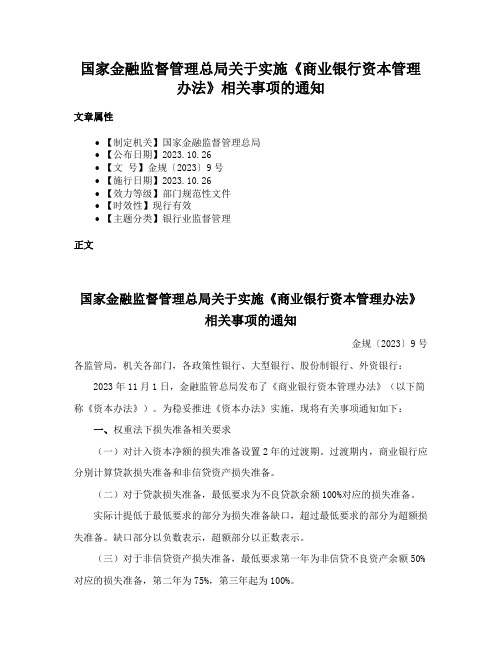
国家金融监督管理总局关于实施《商业银行资本管理办法》相关事项的通知文章属性•【制定机关】国家金融监督管理总局•【公布日期】2023.10.26•【文号】金规〔2023〕9号•【施行日期】2023.10.26•【效力等级】部门规范性文件•【时效性】现行有效•【主题分类】银行业监督管理正文国家金融监督管理总局关于实施《商业银行资本管理办法》相关事项的通知金规〔2023〕9号各监管局,机关各部门,各政策性银行、大型银行、股份制银行、外资银行:2023年11月1日,金融监管总局发布了《商业银行资本管理办法》(以下简称《资本办法》)。
为稳妥推进《资本办法》实施,现将有关事项通知如下:一、权重法下损失准备相关要求(一)对计入资本净额的损失准备设置2年的过渡期。
过渡期内,商业银行应分别计算贷款损失准备和非信贷资产损失准备。
(二)对于贷款损失准备,最低要求为不良贷款余额100%对应的损失准备。
实际计提低于最低要求的部分为损失准备缺口,超过最低要求的部分为超额损失准备。
缺口部分以负数表示,超额部分以正数表示。
(三)对于非信贷资产损失准备,最低要求第一年为非信贷不良资产余额50%对应的损失准备,第二年为75%,第三年起为100%。
实际计提低于上述最低要求的部分为损失准备缺口,超过最低要求但未达到非信贷不良资产余额100%的部分不可计入超额损失准备,超过非信贷不良资产余额100%的部分才能计入超额损失准备。
缺口部分以负数表示,超额部分以正数表示。
(四)商业银行应将贷款损失准备和非信贷资产损失准备的缺口部分和超额部分进行加总,加总结果为负数应扣减核心一级资本,为正数可计入二级资本,但不得超过《资本办法》规定的上限。
(五)过渡期结束后,商业银行损失准备最低要求是指不良资产余额100%对应的损失准备。
金融监管总局对损失准备最低要求另有规定的从其规定。
(六)商业银行应充分评估并持续监测损失准备口径调整对资本充足率的影响。
存在缺口的银行应制定达标规划,经董事会批准后,于2024年6月底前报金融监管总局或其派出机构并认真执行,每半年报告达标进展。
商业银行资本充足率管理办法
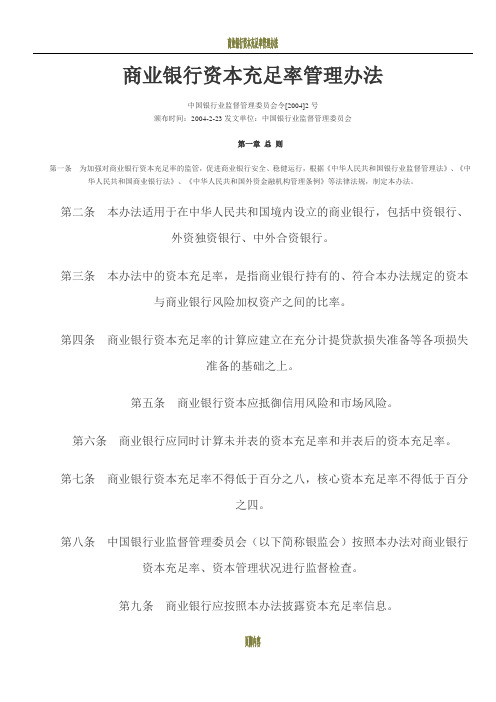
商业银行资本充足率管理办法中国银行业监督管理委员会令[2004]2号颁布时间:2004-2-23发文单位:中国银行业监督管理委员会第一章总则第一条为加强对商业银行资本充足率的监管,促进商业银行安全、稳健运行,根据《中华人民共和国银行业监督管理法》、《中华人民共和国商业银行法》、《中华人民共和国外资金融机构管理条例》等法律法规,制定本办法。
第二条本办法适用于在中华人民共和国境内设立的商业银行,包括中资银行、外资独资银行、中外合资银行。
第三条本办法中的资本充足率,是指商业银行持有的、符合本办法规定的资本与商业银行风险加权资产之间的比率。
第四条商业银行资本充足率的计算应建立在充分计提贷款损失准备等各项损失准备的基础之上。
第五条商业银行资本应抵御信用风险和市场风险。
第六条商业银行应同时计算未并表的资本充足率和并表后的资本充足率。
第七条商业银行资本充足率不得低于百分之八,核心资本充足率不得低于百分之四。
第八条中国银行业监督管理委员会(以下简称银监会)按照本办法对商业银行资本充足率、资本管理状况进行监督检查。
第九条商业银行应按照本办法披露资本充足率信息。
第二章资本充足率计算第十条商业银行计算并表后的资本充足率时,应将以下机构纳入并表范围:(一)商业银行拥有其过半数以上(不包括半数)权益性资本的被投资金融机构,包括:商业银行直接拥有其过半数以上权益性资本的被投资金融机构;商业银行的全资子公司拥有其过半数以上权益性资本的被投资金融机构;商业银行与其全资子公司共同拥有其过半数以上权益性资本的被投资金融机构。
(二)商业银行不拥有其过半数以上的权益性资本,但与被投资金融机构之间有下列情况之一的,应将其纳入并表范围:通过与其他投资者之间的协议,持有该机构半数以上的表决权;根据章程或协议,有权控制该机构的财务和经营政策;有权任免该机构董事会或类似权力机构的多数成员;在该机构董事会或类似权力机构有半数以上投票权。
可以不列入并表范围的机构包括:已关闭或已宣告破产的金融机构;因终止而进入清算程序的金融机构;决定在一年之内售出而短期持有其过半数以上权益性资本的金融机构;受所在国外汇管制及其他突发事件影响、资金调度受到限制的境外附属金融机构。
商业银行资本管理办法

商业银行资本管理办法商业银行资本管理办法1. 引言商业银行资本管理办法是为了规范和指导商业银行的资本管理行为,确保商业银行在风险管理和业务发展中具备充足的资本,保障金融体系的稳定运行而制定的。
本文档将介绍商业银行资本管理办法的重要内容。
2. 资本管理的意义商业银行作为金融机构,其资本是维持其正常经营和发展的重要保障。
充足的资本可以增强商业银行抵御风险的能力,降低破产风险,提供稳定的金融服务。
因此,良好的资本管理是商业银行稳定运营的基础。
3. 资本管理原则商业银行资本管理应遵循以下原则:- 充足性原则:商业银行应维持足够的资本储备,以应对可能的风险和损失。
- 合理性原则:商业银行应根据自身风险状况和业务模式,合理配置和利用资本。
- 透明度原则:商业银行应向内外部利益相关方清晰地披露资本管理情况,提高透明度和信息披露水平。
- 稳健性原则:商业银行应制定风险管理策略,确保资本充足,并及时监测、评估和应对风险。
4. 资本管理要求商业银行资本管理应满足以下要求:4.1 资本充足率要求商业银行应按照监管机构规定的资本充足率要求,维持足够的资本储备,以覆盖可能的风险和损失。
资本充足率要求根据商业银行的风险水平和经营情况而定,监管机构将定期评估商业银行的资本充足状况。
4.2 资本组成要求商业银行的资本应由核心一级资本、附加一级资本和二级资本组成。
核心一级资本是商业银行的最高层级资本,能够吸收损失并维持其正常经营。
附加一级资本和二级资本是以补充核心一级资本的形式存在,用于增强商业银行的资本充足性。
4.3 资本监管和评估监管机构将对商业银行的资本管理情况进行监管和评估,包括资本充足状况、资本构成、风险管理能力等方面。
商业银行应配合监管机构的监管和评估工作,并及时采取措施改进资本管理情况。
5. 资本管理的挑战与展望随着金融市场的不断发展和竞争加剧,商业银行资本管理面临一些挑战。
例如,商业银行需要在充足资本和业务发展之间找到平衡点,还需要应对不确定性和新兴风险的挑战。
商业银行资本管理办法(试行)

商业银行资本管理办法(试行)第一章总则为了规范商业银行的资本管理行为,加强资本监管,维护金融市场稳定,促进金融风险的有效防控,根据《商业银行法》和相关法律法规,制定本办法。
第二章资本计量及要求第一节资本计量方法商业银行的资本计量应符合国内外通行的标准和原则,采用风险敞口法进行计量。
商业银行应根据其不同业务和风险特征,通过风险权重调整因素,计算各项资产的风险敞口。
第二节资本充足率要求商业银行应保持足够的资本充足率,以确保其具备持续运营的能力和抵御风险的能力。
资本充足率应按照国家银行监管机构的要求进行计算和披露。
第三节资本补充商业银行在资本充足率不达标的情况下,应及时采取相应的措施进行资本补充。
资本补充可通过股权融资、债券发行等方式进行,但应符合相关法律法规的规定。
第三章资本管理措施第一节内部资本管理商业银行应建立健全内部资本管理制度,明确资本管理的责任和流程,确保资本充足率的监测和控制。
第二节风险资本分配商业银行应根据不同业务和风险水平,合理分配风险资本。
风险资本分配的原则包括但不限于风险控制、盈利能力和负债能力等因素。
第三节监测和报告商业银行应建立健全监测和报告机制,定期对资本充足率进行监测和报告,及时发现和应对资本缺口和风险暴露。
第四章监管措施第一节监管指标国家银行监管机构应根据商业银行的资本情况和风险水平,制定并监测相关监管指标,对不符合要求的商业银行采取相应的监管措施。
第二节复核和评估国家银行监管机构有权对商业银行的资本管理情况进行复核和评估,发现问题时应及时提出整改要求,并监督整改的落实情况。
第三节处罚措施对于严重违反资本管理要求的商业银行,国家银行监管机构有权采取相应的处罚措施,包括但不限于罚款、吊销执照等。
第五章附则本办法自发布之日起施行,废止《商业银行资本管理办法(试行)》。
以上为商业银行资本管理办法(试行)的主要内容,具体的资本计量、资本要求和监管措施等细则,详见相应法规和规章。
法律规定银行资本充足率(3篇)

第1篇引言资本充足率是衡量银行风险承受能力和金融体系稳健性的重要指标。
银行作为金融体系的核心,其资本充足率直接关系到金融市场的稳定和经济的健康发展。
为了规范银行经营行为,防范金融风险,世界各国普遍对银行的资本充足率进行了法律规定。
本文将从我国相关法律法规出发,探讨银行资本充足率的规定及其意义。
一、我国银行资本充足率的法律规定1. 《商业银行法》《商业银行法》是我国商业银行的基本法律,其中对银行的资本充足率作出了明确规定。
根据《商业银行法》第四十三条规定,商业银行的资本充足率不得低于8%,核心资本充足率不得低于4%。
2. 《商业银行资本管理办法》《商业银行资本管理办法》是我国商业银行资本管理的专项法规,对银行资本充足率的要求更为详细。
该办法明确了资本充足率的计算方法、资本充足率监管指标、资本充足率风险管理等内容。
(1)资本充足率的计算方法《商业银行资本管理办法》规定,银行资本充足率的计算公式为:资本充足率 = (资本-扣除项)/(风险加权资产+12.5倍的市场风险资本)其中,资本包括核心资本和附属资本,扣除项包括商誉、递延税项等。
(2)资本充足率监管指标《商业银行资本管理办法》规定了资本充足率监管指标,包括:- 核心资本充足率:不得低于4%- 总资本充足率:不得低于8%- 净资本充足率:不得低于6%(3)资本充足率风险管理《商业银行资本管理办法》要求银行建立健全资本充足率风险管理体系,包括资本充足率监控、资本充足率评估、资本充足率预警等。
3. 《商业银行风险管理办法》《商业银行风险管理办法》对银行风险管理制度进行了全面规定,其中也涉及了资本充足率的要求。
该办法要求银行建立健全风险管理体系,确保资本充足率符合监管要求。
二、银行资本充足率的规定意义1. 保障金融稳定银行资本充足率是防范金融风险的重要手段。
通过规定银行资本充足率,可以有效控制银行风险,保障金融市场的稳定。
2. 促进银行稳健经营资本充足率的规定促使银行加强风险管理,提高资本管理水平,从而实现稳健经营。
商业银行资本充足率管理办法

商业银行资本充足率管理办法商业银行资本充沛率管理方法(2022修正)Measures for the Management of Capital Adequacy Ratios of Commercial Banks(Promulgated and implemented by Order No. 2 [2022] of China Banking Regulatory Commission and amended according to the Decision of China Banking Regulatory Commission on Revising the Measures for the Management of Capital Adequacy Ratios of Commercial Banks as adopted at the 55th chairmen's meeting of China Banking Regulatory Commission on December 28, 2022)Chapter I General ProvisionsArticle 1 In order to strengthen the supervision over the capital adequacy ratios of commercial banks, promote the safety and stability of commercial banks, the present Measures are formulated in accordance with the Banking Supervision Law of the People's Republic of China, the Law of the People's Republic of China on Commercial Banks, the Administrative Regulations of the People's Republic of China on Foreign-funded Financial Institutions and other relevant laws and regulations.Article 2 The present Measures shall be applicable to the commercial banks established within the territory of the People's Republic of China, including Chinese-funded banks, whollyforeign-funded banks and Sino-foreign equity joint banks.Article 3 The term "capital adequacy ratio" as mentioned in the present Measures refers to the ratio between the capital, which is held by a commercial bank and meets the requirements of the Present Measures,and the risk-weighted assets of the commercial bank.The "core capital adequacy ratio of a commercial bank" refers to the ratio between the core capital, which is held by the commercial bank and meets the requirements of the present Measures, and the risk-weighted assets of the commercial bank.Article 4 The calculation of the capital adequacy ratio of a commercial bank shall be based on provision for loan loss and other losses.Article 5 The capital of a commercial bank shall prevent credit risk and market risk.Article 6 A commercial bank shall simultaneously calculate the unconsolidated capital adequacy ratio and the consolidated capital adequacy ratio.Article 7 The capital adequacy ratio shall not be lower than 8%, the core capital adequacy ratio shall not be lower than 4%.Article 8 China Banking Regulatory Commission (hereinafter referred to as the CBRC)shall conduct supervision and inspection over the capital adequacy ratios and the capital management status of commercial banks.Article 9 The commercial banks shall disclose the information related to capital adequacy ratios in accordance with the present Measures.Chapter II Calculation of Capital Adequacy RatiosArticle 10 When calculating the consolidated capital adequacy ratio, a commercial bank shall list the following institutions into the consolidation scope:(1)The financial institutions with more than half of their equity capital owned by the commercial bank, including:(a)A financial institution with more than half of its equity capital directly owned by the commercial bank;(b)A financial institution with more than half of its equity capital owned by its wholly-funded subsidiary;(c)A financial institution with more than half of its equity capital owned by the commercial bank and its wholly-funded subsidiary.(2)A financial institution with at least half of its equity capital not owned by the commercial bank shall be listed into the consolidation scope if the commercial bank:(a)holds more than half of its voting rights by concluding agreements with other investors;(b)has the power to control the financial affairs and operating policies of this institution according to the articles of association or agreement;(c)has the power to appoint or dismiss most of the members in the board of directors or the similar powerful institution of this financial institution; or(d)holds more than half of the voting rights in the board of directors or the similar powerful institution.The institutions that may not be listed into the consolidation scope shall include the financial institutions that have been closed or have been announced bankruptcy; the financial institutions that have entered into theliquidation procedure; the financial institutions with more than half of their equity capital owned by the commercial bank, which decides to sell it out within a year; the overseas subsidiary financial institutions whose fund procurement capacity is limited due to the control on foreign exchange by the countries where they are located or the impact of other emergencies.Article 11 The calculation formulas of the capital adequacy ratio of a commercial bank:The capital adequacy ratio = (capital - the deduction items)/ (the risk-weighted assets + 12.5 times of market risk capital)The core capital adequacy ratio = (core capital - core capital deduction items)/ (the risk-weighted assets + 12.5 times of market risk capital)Article 12 The capital of a commercial bank includes the core capital and supplementary capital.The core capital includes the paid-up capital or common stocks, capital reserves, surplus reserves, undistributed profits and minority interests.The supplementary capital includes the re-evaluation reserves, general reserves, preferred stocks, convertible bonds, fixed capital bonds and long-term subordinated debts.The positive alteration, but no more than 50%, to the fair value of available-for-sale bonds that have been calculated into the owners' rights and interests may be calculated into the supplementary capital; and the negative alteration to the fair value shall be deducted from the supplementary capital. When a commercial bank calculates the capital adequacy ratio, it shall transfer the fair value of available-for-sale bondsthat have been calculated into the capital reserves from the core capital into the supplementary capital.Article 13 The supplementary capital of a commercial bank shall not exceed 100 % of its core capital. The long-term subordinated debts listed into the supplementary capital shall not exceed 50% of the core capital.Article 14 When calculating the capital adequacy ratio, the commercial bank shall deduct the following items from the capital:(1)Goodwill;(2)50% of the capital investment made by the commercial bank in the unconsolidated financial institutions; and(3)50% of the investment made by the commercial bank innon-self-use immovable property and enterprise capital.Article 15 When calculating the core capital adequacy ratio, the commercial bank shall deduct the following items from the core capital:(1)Goodwill;(2)50% of the capital investment made by the commercial bank in the unconsolidated financial institutions; and(3)50% of the capital investment made by the commercial bank in non-self-use immovable property and enterprise.Article 16 When calculating the weighted-risk assets of all loans, the commercial bank shall deduct the specific reserve from the book value of the loans, and shall deduct the provision for the depreciation of other types of assets from the book values of the corresponding assets.Article 17 The external credit grade evaluation result of the corresponding country or region shall be the benchmark of the risk weight of a commercial bank's credit abroad. When differentcredit grade evaluation companies have different evaluation results about the same country or region, the relatively lower one shall be chosen as the benchmark.(1)With regard to the credits held by it against the government of another country or region, if this country or region is with rating as AA or higher, the risk weight is 0%; if lower than AA, the risk weight is 100%;(2)With regard to the credits held by it against an overseas commercial bank or securities company, if the country or region where this commercial bank or securities company is located is with rating as AA or higher, the risk weight is 50%; if lower than AA, the risk weight is 100%.(3)With regard to the credits held by it against a public utility enterprise invested by the government of another country or region, if this country or region is with rating as AA or higher, the risk weight is 50%; if lower than AA, the risk weight is 100%.Article 18 The risk weight of the credits held by a commercial bank against a multi-lateral development bank shall be 0%.Article 19 The risk weight of all the credits in RMB or foreign currencies held by a commercial bank against the Central Government of our country and the People's Bank of China shall be 0%.The risk weight of the credits held by a commercial bank against the public utility enterprises invested by the Central Government of our country shall be 50%.Article 20 The risk weight of the credits held by a commercial bank against a policy bank of our country shall be 0%.Article 21 The risk weight of the credits held by a commercial bank against another commercial bank of our country shall be 20%, and the risk weight of the credits with an original time limit of four months or shorter shall be 0%.The risk weight of fixed capital bonds and long-term subordinated debts held by a commercial bank against another commercial bank of our country shall be 100%.Article 22 The risk weight of a commercial bank's directional bonds issued by the financial asset management companies invested by the Central Government of our country for the purpose of purchasing thenon-performing loans of state-owned banks shall be 0%.The risk weight of the other credits held by a commercial bank against the financial asset management companies invested by the Central Government of our country shall be 100%.Article 23 The risk weight of the credits held by a commercial bank against an enterprise, individual or other assets shall be 100%.Article 24 The risk weight of individual housing mortgage loans shall be 50%.Article 25 The following items can play a role of mitigating the risks:(1)The specified cash in the form of a special account, sealed money or security;(2)Gold;(3)Bank deposit certificates;(4)The state debts issued by the Ministry of Finance of our country;(5)The instruments issued by the People's Bank of China;(6)The bonds and instruments issued by the policy banks or commercial banks of our country and the drafts honored by them;(7)The bonds and instruments issued by the public utility enterprises invested by the Central Government of our country and the drafts honored by them;(8)The bonds issued by the government of a country or region with rating AA or higher, the bonds and instruments issued by the commercial banks and securities companies registered in this country or region, or the public utility enterprises invested by the government, and the drafts honored by them; and(9)The bonds issued by multi-lateral development banks.A loan by putting any of the items as mentioned in the preceding paragraph in pledge shall obtain the same risk weight as the corresponding item or the risk weight of the direct credit held by the issuer or acceptor of the corresponding item. With regard to a loan with any item partly pledged, the part under protection of the item shall obtain the corresponding low risk weight.Article 26 The guaranties provided by the following guaranty subjects can play a role in mitigating the risks:(1)The policy banks and commercial banks of our country;(2)The state organs of our country approved by the State Councilto re-lend loans extended by foreign governments or international economic organizations;(3)The public utility enterprises invested by the Central Government of our country;(4)The governments of the countries or regions with rating as AA or higher, the commercial banks registered in these countries or regions and the public utility enterprises invested by the governments of these countries or regions; and(5)Multi-lateral development banks.A loan on the basis of the full guaranty provided by any of the guaranty subjects as mentioned in the preceding paragraph shall have the same risk weight as the direct credit against the guarantor. As for a loan partly guaranteed, the guaranteed part of the loan shall have the corresponding low risk weight.Article 27 A commercial bank shall calculate and deduct the capital for the credit risks of the unconsolidated businesses.A commercial bank shall multiply the unconsolidated businesses in the name of the unconsolidated items by the credit conversion coefficient, obtaining the risk assets identical with the consolidated items, then it shall determine their risk weights according to the transaction objects, finally it shall calculate the corresponding risk-weighted assets of the unconsolidated items.The risk-weighted assets of exchange rates, interest rates and other agreements on derivative products shall be calculated through the current risk exposure approach.Article 28 A commercial bank shall calculate and deduct the capitalfor market risk.The term "market risks" refers to the risks of losses of consolidated and unconsolidated positions caused by the variation of market price. The market risks as mentioned in the present Measures include risks that various financial instruments and stocks in the transaction account may be affected by interest rates, all the risks of foreign exchange and risks of commodities of a commercial bank.Article 29 A commercial bank shall establish a transaction account. The prices of all the items in the transaction account shall be calculated according to the market prices.The transaction account shall cover the positions of financial instruments held for a short period by the commercial bank in carrying on self-operations and expected to yield profits from the actual or expected price differences, or the variation of other prices or interest rates in future sales or dealings; the positions held for making dealings entrusted by clients and making market; and positions held for avoiding risks of the transaction account and other items.Article 30 A commercial bank whose total positions in the transaction account exceed 10% of the total assets or RMB 8.5 billion yuan shall calculate and deduct the market risk capital.Article 31 A commercial bank that isn't required to calculate and deduct market risk capital according to the present Measures shall report its market risk positions to the China Banking Regulatory Commission (hereinafter referred to as CBRC)each quarter.Article 32 A commercial bank shall calculate the market risk capital through the standard approach as prescribed in the present Measures. Upon examination and approval of the CBRC, a commercial bank may calculate market risk capital through the internal model approach.Chapter III. Supervision and InspectionArticle 33 The board of directors of a commercial bank shall bear the final liabilities for the capital adequacy management of this bank, shall be responsible for determining the target of capital adequacy management, shall examine and decide the risk capacity and shall formulate andconduct supervision over the implementation of capital plans. Where the commercial bank has established the board of directors, the president of the bank shall be responsible.Article 34 The senior managerial personnel of a commercial bank shall be responsible for carrying out capital adequacy management, which includes formulating bylaws on the capital adequacy management of this bank, perfecting the identification, measurement and reporting procedures for credit risks and market risks, shall regularly assess the capital adequacy level, shall establish corresponding capital management mechanism, shall strengthen the examination and audit over the capital assessment procedure and shall ensure that all supervisory and control measures be carried out effectively.Article 35 A commercial bank shall report the unconsolidated and consolidated capital adequacy ratios to the CBRC. The consolidated capital adequacy ratio shall be reported once every half year and the unconsolidated capital adequacy ratio shall be reported once every quarter. When confronting any extremely serious matter involving capital adequacy, it shall report it to CBRC in time.Article 36 The CBRC shall conduct on-the-spot inspection andnon-on-the-spot monitoring over the capital adequacy ratio of each commercial bank. The inspection shall mainly cover the following:(1)The formulation and implementation of the bylaws related to the capital adequacy ratio of the commercial bank;(2)The commercial bank's capital plan on keeping the capital adequacy ratio and its implementation of the plan, its ability and methods to monitor the capital level;(3)The status of the credit risks and market risks of the commercial bank; and(4)Whether the establishment of the transaction account or the item pricing meets the provisions of the present Measures.Article 37 The CBRC may ask a commercial bank to increase the minimum standard for capital adequacy ratio according to its risk status and risk management capacity.Article 38 The CBRC may classify the commercial banks into the following three categories on the basis of their respective capital adequacy ratio:(1)Commercial banks with adequate capital: the capital adequacy ratio not lower than 8%, the core capital adequacy ratio not lower than 4%;(2)Commercial banks with inadequate capital: the capital adequacy ratio lower than 8%, or the core capital adequacy ratio lower than 4%; and(3)Commercial banks whose capital is seriously inadequate: the capital adequacy ratio lower than 4 %, or the core capital adequacy ratio lower than 2%.Article 39 The CBRC shall encourage the commercial banks withadequate capital to develop business stably and soundly. In order to prevent their capital adequacy ratio from sliding lower than the minimum standard, the CBRC shall adopt the following control measures:(1)To ask the commercial banks to perfect the bylaws on risk management;(2)To ask the commercial banks to increase the risk control capacity;(3)To ask the commercial banks to strengthen the analyses and forecasts about the capital adequacy ratios; and(4)To ask the commercial banks to formulate practical and feasible capital keeping plan, and to impose limits on their participation in some high risk business.Article 40 The CBRC shall take the following rectification measures against a commercial bank with inadequate capital:(1)To give the commercial bank supervisory advices, which shall include descriptions of the status quo of the commercial bank's capital adequacy ratio, the to-be-taken rectification measures and the detailed plan on the implementation of all the measures;(2)To ask the commercial bank to formulate practical and feasible capital complement plan within 2 months from the day when it receives the supervisory advices of the CBRC;(3)To ask the commercial bank to control the capital increase speed;(4)To ask the commercial bank to reduce the scale of risk assets;(5)To ask the commercial bank to control the purchase of fixed assets; and(6)To conduct strict examination or control on the establishment of new institutions or new operations by the commercial bank.In case a commercial bank still fails to make correction within the time limit after being given the rectification measures as provided in the preceding paragraph, or its act has seriously endangered the stable operation of this commercial bank, damaged the legitimate rights and interests of depositors or other clients, the CBRC shall, according to the risk degree of the commercial bank and the implementation of capital complement plan, have the power to restrict the commercial bank from distributing bonuses and other incomes, order the commercial bank to suspend all operations except the low risk ones, and suspend examining and approving the establishment of any new institution and new operation by the commercial bank.Article 41 With regard to a commercial bank facing serious shortage of capital, the CBRC may take the following rectification measures besides those as listed in Article 40 of the present Measures:(1)To ask the commercial bank to change the senior managerial personnel; and(2)To take over the commercial bank or urge it to restructure, even to cancel it.When dealing with this kind of commercial banks, the CBRC shall take into account the external factors comprehensively, and shall take other necessary measures.Chapter IV Information DisclosureArticle 42 The board of directors of a commercial bank shall be responsible for the information disclosure of the capital adequacy of this bank. If there is no board of directors, the president of the bank shall be responsible. The content of the information disclosure shall be subject to the approval of the board of directors or president.Article 43 The information disclosure of the capital adequacy ratio shall mainly include five aspects: the risk management target and policy, the consolidation scope, capital, capital adequacy ratio, credit risks and market risks. With regard to the items that can't be disclosed due to involving commercial secrets, the commercial bank may disclose the overall information about the items that can be disclosed and make explanations about the special items that can't be disclosed.Article 44 A commercial bank shall disclose the information about its capital adequacy ratio within 4 months after the end of every fiscal year. Where it is unable to disclose the said information within the time limit for special reason, it shall file an application to the CBRC for extension at least 15 days prior to the deadline.Article 45 The capital adequacy ratio information of a commercial bank shall be reported to the CBRC before it is disclosed.Article 46 A commercial bank shall announce the information required in disclosure by the present Measures, and shall ensure that the shareholders and relevant interested persons obtain the information in time.Chapter V Supplementary ProvisionsArticle 47 The calculation of the capital adequacy ratio of a wholly foreign-funded financing company or joint equity financing company, the supervision and examination and the information disclosure shall be made by referring to the present Measures. A foreign bank's branch inChina shall calculate the RMB risk weighted assets by referring to the risk weights as prescribed in the present Measures.The calculation, supervision and administration of capital adequacy ratio of a policy bank shall be carried out by referring to the present Measures, however, there is no uniform requirement for the disclosure of capital adequacy ratio of the policy bank.Article 48 Attachments 1 to 5 are component parts of the present Measures, which shall cover the following:(1)Attachment 1: The Definitions of Capital;(2)Attachment 2: The Risk Weights of Consolidated Assets;(3)Attachment 3: The Credit Conversion Coefficients of Unconsolidated Items and Definitions of Unconsolidated Items;(4)Attachment 4: The Standard Approach as Required for Calculating Market Risk Capital;(5)Attachment 5: The Content of Information DisclosureArticle 49 The Standard & Poor's rating denotation "AA" is adopted in the present Measures, but no limit is set on the commercial banks' options of external credit rating companies, the commercial banks may choose the rating result of a rating company by themselves, and keep the consistency.Article 50 The credits against the governments of other countries or regions include the credits against the governments of these countries or regions, their central banks and other institutions equivalent to the governments. The definition of the term "institutions equivalent to the governments" shall be in line with the regulations of the local bankingsupervisory authorities.Article 51 The term "equity capital" refers to the capital that gives the holder the right to participate in the company management and the voting power in operational decision-making.Article 52 The term "public utility enterprises" refers to the operators of public utilities, including the supplies of water, electricity, heat and gas, post, telecommunication, transport and transportation and other industries. The public utilities are mainly distributed in the basic industries of national economy, and most of them undertake the task of providing services to the general public. These enterprises are usually established by the state by making huge investment from the government finance.Article 53 The power to interpret the present Measures shall remain with China Banking Regulatory Commission.Article 54 The present Measures shall be implemented as of March 1, 2022.文档内容到此结束,欢迎大家下载、修改、丰富并分享给更多有需要的人。
商业银行资本充足率管理办法

商业银行资本充足率管理办法第一章总则第一条为了加强商业银行资本监管,确保商业银行稳健经营,维护银行业公平竞争,根据《中华人民共和国银行业监督管理法》、《中华人民共和国商业银行法》等法律法规,制定本办法。
第二条本办法适用于在中华人民共和国境内设立的商业银行。
第三条商业银行应当按照本办法规定,计算并披露其资本充足率。
第四条中国银行业监督管理委员会(以下简称银监会)负责商业银行资本充足率的监督管理。
第二章资本充足率的计算和披露第五条商业银行资本充足率,是指商业银行资本与风险加权资产的比率。
第六条商业银行资本,包括核心资本和附属资本。
第七条风险加权资产,是指商业银行在经营过程中面临的各种风险,按照一定的权重进行计算的资产。
第八条商业银行应当按照银监会规定的方法,计算其资本充足率。
第九条商业银行应当在每个季度结束后的一个月内,向银监会提交其资本充足率的计算结果和有关资料。
第十条商业银行应当在其年度报告中,披露其资本充足率及其计算方法。
第三章监督管理第十一条银监会应当对商业银行资本充足率进行定期检查和不定期抽查。
第十二条商业银行应当配合银监会的检查和抽查,提供真实、完整、准确的资料。
第十三条银监会可以根据商业银行资本充足率的计算结果和经营情况,采取必要的监管措施,包括但不限于:要求商业银行增加资本、减少风险加权资产、限制资产增长等。
第十四条商业银行资本充足率低于法定标准的,银监会可以要求商业银行制定整改计划,并在规定时间内达到标准。
第十五条商业银行未按照本办法规定计算和披露资本充足率的,银监会可以对其进行处罚,包括但不限于:罚款、吊销经营许可证等。
第四章附则第十六条本办法自发布之日起施行。
第十七条本办法由中国银行业监督管理委员会负责解释。
商业银行资本管理办法(试行)

商业银行资本管理办法(试行)文章属性•【制定机关】中国银行业监督管理委员会(已撤销)•【公布日期】2012.06.07•【文号】中国银行业监督管理委员会令2012年第1号•【施行日期】2013.01.01•【效力等级】部门规章•【时效性】部分失效•【主题分类】银行业监督管理正文本篇法规中的第二十五条规定已被《系统重要性银行附加监管规定(试行)》(中国人民银行、中国银行保险监督管理委员会令〔2021〕第5号)自2021年12月1日起停止适用。
中国银行业监督管理委员会令(2012年第1号)《商业银行资本管理办法(试行)》已经中国银监会第115次主席会议通过,现予公布,自2013年1月1日起施行。
主席:尚福林二○一二年六月七日商业银行资本管理办法(试行)第一章总则第一条为加强商业银行资本监管,维护银行体系稳健运行,保护存款人利益,根据《中华人民共和国银行业监督管理法》、《中华人民共和国商业银行法》、《中华人民共和国外资银行管理条例》等法律法规,制定本办法。
第二条本办法适用于在中华人民共和国境内设立的商业银行。
第三条商业银行资本应抵御其所面临的风险,包括个体风险和系统性风险。
第四条商业银行应当符合本办法规定的资本充足率监管要求。
第五条本办法所称资本充足率,是指商业银行持有的符合本办法规定的资本与风险加权资产之间的比率。
一级资本充足率,是指商业银行持有的符合本办法规定的一级资本与风险加权资产之间的比率。
核心一级资本充足率,是指商业银行持有的符合本办法规定的核心一级资本与风险加权资产之间的比率。
第六条商业银行应当按照本办法的规定计算并表和未并表的资本充足率。
第七条商业银行资本充足率计算应当建立在充分计提贷款损失准备等各项减值准备的基础之上。
第八条商业银行应当按照本办法建立全面风险管理架构和内部资本充足评估程序。
第九条中国银行业监督管理委员会(以下简称银监会)依照本办法对商业银行资本充足率、资本管理状况进行监督检查,并采取相应的监管措施。
商业银行资本充足率管理办法

商业银行资本充足率管理办法商业银行资本充足率管理是保障金融体系稳健运行的重要措施之一。
为了规范商业银行资本充足率管理,提高金融机构风险抵御能力和防范金融风险的能力,我国制定了商业银行资本充足率管理办法,以下将对其主要内容进行介绍。
一、资本充足率的定义和意义资本充足率是指商业银行核心资本和风险加权资产的比率,用于衡量银行的风险承受能力和业务发展的稳定性。
资本充足率的合理水平可以保障金融机构的偿债能力,稳定金融市场,防范金融风险。
二、资本充足率的计算方法商业银行资本充足率的计算方法主要有三个指标:核心资本充足率(CET1充足率)、一级资本充足率(Tier 1充足率)和总资本充足率。
核心资本充足率是指商业银行的核心资本与风险加权资产之比,一级资本充足率是指商业银行的核心资本和附加一级资本与风险加权资产之比,总资本充足率是指商业银行的核心资本、附加一级资本和二级资本与风险加权资产之比。
三、资本充足率的监管要求商业银行资本充足率管理办法规定了商业银行资本充足率的监管要求,包括最低资本充足率比例、资本类别的划分和监管指标的核算方法等方面。
其中,最低资本充足率比例是根据商业银行业务规模、资产质量、市场风险等因素确定的,以确保商业银行稳健经营。
四、资本充足率管理的作用和意义商业银行资本充足率管理办法的实施,对于保障金融体系稳健运行和防范金融风险具有重要作用。
首先,资本充足率管理可以促使商业银行优化资产负债结构,提高盈利能力和抗风险能力。
其次,通过合理设置资本充足率要求,可以限制商业银行过度扩张和过度借贷行为,避免系统性风险的发生。
再次,资本充足率管理可以提高风险管理意识,促使商业银行加强内部控制体系的建设,提高管理水平和风险防控能力。
五、资本充足率管理存在的问题和挑战尽管商业银行资本充足率管理办法的实施有利于金融风险防范,但也面临一些问题和挑战。
首先,资本充足率的计算方法和监管要求可能存在不足之处,需要不断完善和修订。
商业银行资本管理办法(试行)(中国银监令2012第1号)

商业银行资本管理办法(试行)第一章总则第一条为加强商业银行资本监管,维护银行体系稳健运行,保护存款人利益,根据《中华人民共和国银行业监督管理法》、《中华人民共和国商业银行法》、《中华人民共和国外资银行管理条例》等法律法规,制定本办法。
第二条本办法适用于在中华人民共和国境内设立的商业银行。
第三条商业银行资本应抵御其所面临的风险,包括个体风险和系统性风险。
第四条商业银行应当符合本办法规定的资本充足率监管要求。
第五条本办法所称资本充足率,是指商业银行持有的符合本办法规定的资本与风险加权资产之间的比率。
一级资本充足率,是指商业银行持有的符合本办法规定的一级资本与风险加权资产之间的比率。
核心一级资本充足率,是指商业银行持有的符合本办法规定的核心一级资本与风险加权资产之间的比率。
第六条商业银行应当按照本办法的规定计算并表和未并表的资本充足率。
第七条商业银行资本充足率计算应当建立在充分计提贷款损失准备等各项减值准备的基础之上。
第八条商业银行应当按照本办法建立全面风险管理架构和内部资本充足评估程序。
第九条中国银行业监督管理委员会(以下简称银监会)依照本办法对商业银行资本充足率、资本管理状况进行监督检查,并采取相应的监管措施。
第十条商业银行应当按照本办法披露资本充足率信息。
第二章资本充足率计算和监管要求第一节资本充足率计算范围第十一条商业银行未并表资本充足率的计算范围应包括商业银行境内外所有分支机构。
并表资本充足率的计算范围应包括商业银行以及符合本办法规定的其直接或间接投资的金融机构。
商业银行及被投资金融机构共同构成银行集团。
第十二条商业银行计算并表资本充足率,应当将以下境内外被投资金融机构纳入并表范围:(一)商业银行直接或间接拥有50%以上表决权的被投资金融机构。
(二)商业银行拥有50%以下(含)表决权的被投资金融机构,但与被投资金融机构之间有下列情况之一的,应将其纳入并表范围:1.通过与其它投资者之间的协议,拥有该金融机构50%以上的表决权。
商业银行资本管理办法最新全文

商业银行资本管理办法最新全文第一章总则第一条为了加强商业银行资本管理,维护银行体系稳健运行,促进经济金融健康发展,根据《中华人民共和国商业银行法》、《中华人民共和国银行业监督管理法》等法律法规,制定本办法。
第二条本办法适用于中华人民共和国境内依法设立的商业银行,包括中资商业银行、外资独资银行、中外合资银行和外国银行分行。
第三条商业银行应当建立科学、有效的资本管理制度,确保资本充足,提高资本质量,增强抵御风险的能力。
第四条银行业监督管理机构应当加强对商业银行资本管理的监管,确保本办法的贯彻执行。
第二章资本充足率要求第五条商业银行应当保持资本充足率不低于8%,核心一级资本充足率不低于5%,一级资本充足率不低于6%。
第六条商业银行应当根据风险状况,合理配置资本,确保资本充足率满足监管要求。
第七条商业银行应当建立动态的资本充足率监测和预警机制,及时发现和纠正资本不足问题。
第三章资本构成与分类第八条商业银行资本包括核心一级资本、其他一级资本和二级资本。
第九条核心一级资本是指商业银行在持续经营和清算情况下,能够吸收损失的资本工具,包括实收资本、资本公积、盈余公积、一般风险准备和未分配利润。
第十条其他一级资本是指商业银行在持续经营和清算情况下,能够吸收损失的资本工具,包括优先股、永续债等。
第十一条二级资本是指商业银行在清算情况下,能够吸收损失的资本工具,包括次级债、混合资本债等。
第十二条商业银行应当根据资本工具的性质和风险特点,合理分类和计量资本。
第四章风险加权资产计量第十三条商业银行应当根据风险程度,对各项资产进行风险加权计量,确定风险加权资产。
第十四条商业银行应当建立全面的风险管理体系,准确识别、计量、监控和控制各类风险。
第十五条商业银行应当根据监管要求,及时调整风险加权资产计量方法和参数。
第五章资本补充与约束第十六条商业银行应当通过内部积累、外部融资等方式,确保资本充足率的稳定和增长。
第十七条商业银行应当合理控制资本消耗,避免过度扩张和盲目投资。
《商业银行资本管理办法

《商业银行资本管理办法商业银行资本管理办法为了有效规范商业银行的资本管理,维护金融系统的稳定和运行,加强风险管理能力,确保金融机构的持续发展和服务实体经济的能力,商业银行资本管理办法在此制定。
一、总则商业银行资本管理办法(以下简称“本办法”)依据《中华人民共和国商业银行法》、《中华人民共和国银行业监督管理法》等法律法规,针对商业银行的资本管理制定,适用于全国范围内的商业银行。
二、资本监管指标1. 资本充足率商业银行应根据风险暴露的不同水平,设置相应的资本充足率要求。
资本充足率是商业银行资本与风险资产的比例,资本充足率的计算公式为:核心资本 / 风险资产。
2. 资本构成商业银行的资本构成应包括核心资本和附属资本。
核心资本包括商业银行的股本、留存收益及其他核心资本工具;附属资本包括商业银行的次级债券和优先股等。
3. 资本监管工具商业银行可通过发行股票、债券或吸收其他金融机构投资来增加资本。
商业银行应按照相关规定制定资本充足计划,并定期向银行监管机构报告资本充足状况。
三、风险管理1. 风险定价和分配商业银行应根据资本市场和经济环境的变化,合理定价和分配风险。
商业银行应建立完善的风险定价模型,评估并确定不同业务和产品所具有的各类风险,确保风险价格与实际风险相匹配。
2. 风险监测和控制商业银行应建立健全的风险监测和控制机制,及时识别风险暴露,并采取适当的风险管理措施。
商业银行的风险监测和控制机制应包括风险度量指标、风险管理流程和风险报告等。
3. 应急情况下的资本管理商业银行应根据风险情况制定相应的应急预案,并及时调整资本结构以应对风险。
在严重风险事件发生时,商业银行应立即采取措施稳定金融市场,保护金融系统的稳定运行。
四、监管和问责1. 监管机构商业银行资本管理的监管机构为银行监管部门。
银行监管部门负责监督商业银行资本管理办法的实施情况,并对不符合要求的商业银行提出相应的风险警示和监管措施。
2. 监督报告和信息披露商业银行应按照相关规定定期向银行监管机构报告资本管理情况,并及时披露相关信息。
2023修正版商业银行资本管理办法(试行)
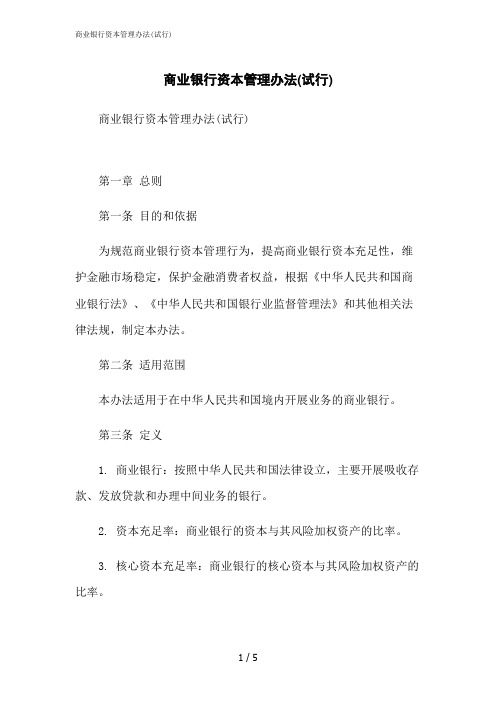
商业银行资本管理办法(试行)商业银行资本管理办法(试行)第一章总则第一条目的和依据为规范商业银行资本管理行为,提高商业银行资本充足性,维护金融市场稳定,保护金融消费者权益,根据《中华人民共和国商业银行法》、《中华人民共和国银行业监督管理法》和其他相关法律法规,制定本办法。
第二条适用范围本办法适用于在中华人民共和国境内开展业务的商业银行。
第三条定义1. 商业银行:按照中华人民共和国法律设立,主要开展吸收存款、发放贷款和办理中间业务的银行。
2. 资本充足率:商业银行的资本与其风险加权资产的比率。
3. 核心资本充足率:商业银行的核心资本与其风险加权资产的比率。
4. 目标资本充足率:商业银行为保持资本充足,维护金融市场稳定所设定的资本充足率。
5. 风险加权资产:商业银行金融风险经济资本占用量。
6. 资本管理工具:商业银行合规进行资本管理的各种工具,包括但不限于股本、准股本和附属资本工具等。
第四条资本管理原则商业银行的资本管理应遵循以下原则:1. 充分性原则:商业银行应保持足够的资本以防范风险和损失;2. 从严管理原则:商业银行应按照法律法规和监管部门规定的要求管理自身资本,并定期进行风险评估和压力测试;3. 合理配置原则:商业银行应合理配置资本,以满足业务经营需要,维护金融市场稳定;4. 创新发展原则:商业银行应积极创新,不断提高资本效益和风险管理能力。
第二章资本充足率要求第五条资本充足率计算方法商业银行的资本充足率应按照监管部门规定的风险加权资产计算方法计算。
第六条目标资本充足率要求商业银行应根据自身风险状况、业务规模和经营特点等因素,设定合理的目标资本充足率水平,并及时报告监管部门。
第七条核心资本充足率要求商业银行应保持核心资本充足率不低于监管部门规定的最低要求。
第八条风险调整资本要求商业银行应根据风险调整资本要求模型,对各项业务进行风险加权资产计算,并根据监管部门要求保持风险调整资本充足。
第三章资本管理工具第九条股本管理商业银行应按照法律法规和监管部门规定,合理配置股本,确保股本充足,并保持股本结构的稳定。
商业银行资本管理办法
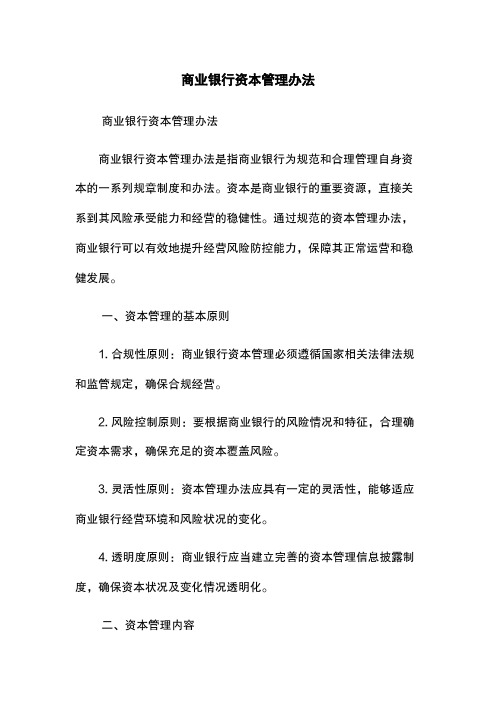
商业银行资本管理办法商业银行资本管理办法商业银行资本管理办法是指商业银行为规范和合理管理自身资本的一系列规章制度和办法。
资本是商业银行的重要资源,直接关系到其风险承受能力和经营的稳健性。
通过规范的资本管理办法,商业银行可以有效地提升经营风险防控能力,保障其正常运营和稳健发展。
一、资本管理的基本原则1. 合规性原则:商业银行资本管理必须遵循国家相关法律法规和监管规定,确保合规经营。
2. 风险控制原则:要根据商业银行的风险情况和特征,合理确定资本需求,确保充足的资本覆盖风险。
3. 灵活性原则:资本管理办法应具有一定的灵活性,能够适应商业银行经营环境和风险状况的变化。
4. 透明度原则:商业银行应当建立完善的资本管理信息披露制度,确保资本状况及变化情况透明化。
二、资本管理内容商业银行资本管理办法主要包括以下内容:1. 资本监管要求商业银行应当根据监管部门的规定,合规确定资本的构成、计量、报告和披露要求,确保符合监管规定。
2. 资本衡量方法商业银行应当合理选择资本衡量方法,包括风险加权资产法、标准法和简化法等,根据自身业务风险特征确定适合的计量方法。
3. 资本充足率管理商业银行应当根据监管要求,合规确定资本充足率标准,确保资本充足率达到监管要求,保障资本充足。
4. 资本维持和恢复商业银行应当建立资本维持和恢复机制,在资本不足时采取相应措施,确保资本水平可以及时恢复到监管要求的水平。
5. 内部资本管理商业银行应当建立完善的内部资本管理机制,包括资本规划、分配、使用、风险监控等,确保资本的有效管理和运用。
6. 资本管理信息披露商业银行应当根据监管要求和市场需求,做好资本管理信息披露工作,向内部和外部相关方提供及时、准确、完整的资本管理信息。
三、风险管理与资本管理的关系风险管理是商业银行经营管理的核心内容,资本管理是风险管理的重要支撑和保障。
有效的资本管理可以帮助商业银行更好地识别、评估和控制风险,提升自身风险承受能力,确保经营的稳健和持续性发展。
商业银行资本充足率管理办法
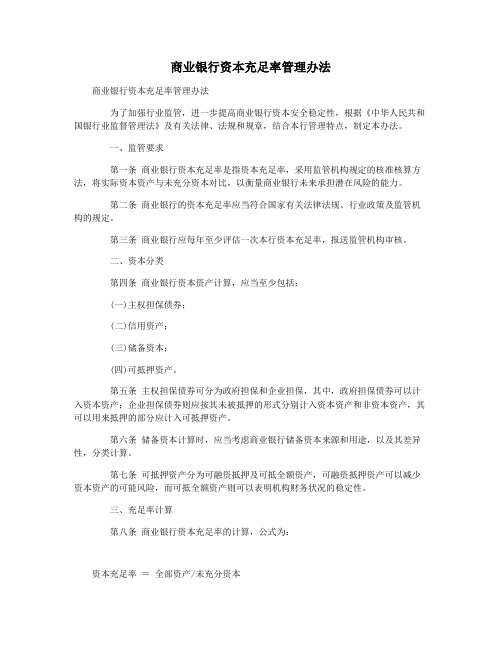
商业银行资本充足率管理办法商业银行资本充足率管理办法为了加强行业监管,进一步提高商业银行资本安全稳定性,根据《中华人民共和国银行业监督管理法》及有关法律、法规和规章,结合本行管理特点,制定本办法。
一、监管要求第一条商业银行资本充足率是指资本充足率,采用监管机构规定的核准核算方法,将实际资本资产与未充分资本对比,以衡量商业银行未来承担潜在风险的能力。
第二条商业银行的资本充足率应当符合国家有关法律法规、行业政策及监管机构的规定。
第三条商业银行应每年至少评估一次本行资本充足率,报送监管机构审核。
二、资本分类第四条商业银行资本资产计算,应当至少包括:(一)主权担保债券;(二)信用资产;(三)储备资本;(四)可抵押资产。
第五条主权担保债券可分为政府担保和企业担保,其中,政府担保债券可以计入资本资产;企业担保债券则应按其未被抵押的形式分别计入资本资产和非资本资产,其可以用来抵押的部分应计入可抵押资产。
第六条储备资本计算时,应当考虑商业银行储备资本来源和用途,以及其差异性,分类计算。
第七条可抵押资产分为可融资抵押及可抵全额资产,可融资抵押资产可以减少资本资产的可能风险,而可抵全额资产则可以表明机构财务状况的稳定性。
三、充足率计算第八条商业银行资本充足率的计算,公式为:资本充足率=全部资产/未充分资本全部资产=资本资产+可抵押资产未充分资本=总资产-被抵押资产第九条全部资产即计算商业银行资本充足率所包含的全部资产,包括有形资产和无形资产等;未充分资本也是商业银行资本充足率计算中包含的所有资本,包括全部履约资产、全部非履约资产和风险资产,以及国际金融超监管体系新的内容。
第十条所有涉及婚姻、财产关系等关联中介机构资产,应以Risk Weighted Assets (RWA)之类的表示方式,根据相关计算模型等计算并记账。
四、体系建设第十一条商业银行应建立本行资本充足率管理体系,建立风险限制体系,建立资本充足率报表及充足率测算等规范。
《商业银行资本充足率管理办法》

《商业银行资本充足率管理办法》为加大商业银行资本充足率监管,增强商业银行应对风险能力,保证商业银行安全、稳健运行,近日,中国银监会公布《商业银行资本充足率监督检查指引》(以下简称《指引》)。
《指引》目前仅适用于新资本协议银行和自愿实施新资本协议的银行,新资本协议银行以外的其他银行参照执行。
作为我国银行业实施新资本协议制度安排的重要组成部分,《指引》是新资本协议第二支柱的具体体现。
《指引》包括5章、105条,确立了商业银行资本充足状况应当与其风险状况相适应的原则,要求商业银行审慎评估银行或银行集团的表内和表外要紧风险,实施资本规划治理,并坚持与银行或银行集团风险状况相适应的资本水平。
第一章明确了商业银行资本充足率监督检查的差不多原则;第二章商业银行内部资本充足评估程序,规定了商业银行内部资本充足评估程序的总体要求和差不多内容;第三章商业银行风险评估标准,即银监会实施资本充足率监督检查的核心内容和差不多方法;第四章监督检查程序,规范了监督检查程序,强调了资本充足率的连续监管;第五章附则,进一步明确了非新协议银行须参照执行以及文件的生效日期。
银监会有关负责人表示,银监会将按照《指引》要求,对银行或银行集团所面临的各类要紧风险及其治理能力进行独立评估,按照评估结果、压力测试结果和经济周期等因素,确定监管资本要求,确保银行或银行集团的资本能够充分覆盖其面临的各类风险。
《指引》的实施,将有效督促商业银行建立全面风险治理框架和内部资本充足评估体系,推动商业银行提升资本治理水平;有利于强化资本监管,完善资本监管制度,有效爱护我国银行业的稳健运行和健康进展。
中国银监会关于印发《商业银行资本充足率监督检查指引》的通知银监发〔2009〕109号各银监局,各政策性银行、国有商业银行、股份制商业银行,邮政储蓄银行:现将《商业银行资本充足率监督检查指引》(以下简称《指引》)印发给你们,请《中国银行业实施新资本协议指导意见》确定的新资本协议银行和自愿实施新资本协议的其他商业银行遵照执行,未实施新资本协议的银行参照执行。
商业银行资本充足率管理办法

资本充足率计算公式资本充足率计算公式:资本充足率计算公式:一、资本充足率= (C - a - b - d×50% - e)×100%/A - b×50% - e×10% 其中:二、C=资本净额 =业务状况表中“所有者权益合计”期末数+“贷款呆帐准备”期末数-“呆帐贷款”期末数-“1422 入股联社资金”借方余额。
A=加权风险资产表内外加权风险资产总额应根据人民银行调查统计部门规定的风险资产分类及权重计算汇总 a=应提未提呆账准备金b=长期反映在呆滞贷款科目,但实际已无法收回的贷款,该部分的贷款的原风险权重为 50% d=长期未处置的抵债资产额,该部分资产预计损失率 50% e=风险程度不明确的投资资产,该部分资产的原风险权重为 10% 三、资本充足率计算公式新资本净额=(资本净额-呆帐准备金不足部分-长期未处置的抵债资产-风险不明确的投资资产)新加权风险资产=加权风险资产-长期未处置抵债资产×50%-风险不明确的投资资产×10%新资本净额/新加权风险资产×100=资本充足率或?新资本净额=(资本净额-呆帐准备金不足部分-长期未处置的抵债资产×50%-呆滞贷款×40%)新加权风险资产=加权风险资产-长期未处置抵债资产×50%-呆滞贷款× 40%新资本净额/新加权风险资产×100=资本充足率。
银行资本充足率计算公式更多说明:银行资本充足率计算公式更多说明:更多说明资本充足率(Capital Adequacy)也称资本充实率,是保证银行等金融机构正常运营和发展所必需的资本比率。
根据《巴塞尔协议》,我国规定商业银行必须达到的资本充足率指标是:包括核心资本和附属资本的资本总额与风险加权资产总额的比率不得低于 8%,其中核心资本与风险加权资产总额的比率不低于 4%。
核心资本包括实收资本、资本公积、盈余公积、未分配利润;附属资本包括贷款呆账准备、坏账准备、投资风险准备和五年期以上的长期债券。
- 1、下载文档前请自行甄别文档内容的完整性,平台不提供额外的编辑、内容补充、找答案等附加服务。
- 2、"仅部分预览"的文档,不可在线预览部分如存在完整性等问题,可反馈申请退款(可完整预览的文档不适用该条件!)。
- 3、如文档侵犯您的权益,请联系客服反馈,我们会尽快为您处理(人工客服工作时间:9:00-18:30)。
商业银行资本充足率管理办法
1
【发布单位】中国银行业监督管理委员会
【发布文号】中国银行业监督管理委员会令第2号
【发布日期】 -02-23
【生效日期】 -03-01
【失效日期】
【所属类别】国家法律法规
【文件来源】中国法院网
商业银行资本充分率管理办法
(中国银行业监督管理委员会令第2号)
《商业银行资本充分率管理办法》已经国务院批准。
现予公布。
自 3月1日起施行。
主席:刘明康
二○○四年二月二十三日?
商业银行资本充分率管理办法
第一章总则
第一条为加强对商业银行资本充分率的监管,促进商业银行安全、稳健运行,根据《中华人民共和国银行业监督管理法》、《中华人民共和国商业银行法》、《中华人民共和国外资金融机构管理条例》等法律法规,制定本办法。
第二条本办法适用于在中华人民共和国境内设立的商业银行,包括中资银行、外资独资银行、中外合资银行。
第三条本办法中的资本充分率,是指商业银行持有的、符合本办法规定的资本与商业银行风险加权资产之间的比率。
第四条商业银行资本充分率的计算应建立在充分计提贷款损失准备等各项损失准备的基础之上。
第五条商业银行资本应抵御信用风险和市场风险。
第六条商业银行应同时计算未并表的资本充分率和并表后的资
本充分率。
第七条商业银行资本充分率不得低于百分之八,核心资本充分率不得低于百分之四。
第八条中国银行业监督管理委员会(以下简称银监会)按照本办法对商业银行资本充分率、资本管理状况进行监督检查。
第九条商业银行应按照本办法披露资本充分率信息。
?
第二章资本充分率计算?
第十条商业银行计算并表后的资本充分率时,应将以下机构纳入并表范围:
(一)商业银行拥有其过半数以上(不包括半数)权益性资本的被投资金融机构,包括:
1.商业银行直接拥有其过半数以上权益性资本的被投资金融机构;
2.商业银行的全资子公司拥有其过半数以上权益性资本的被投资金融
机构;
3.商业银行与其全资子公司共同拥有其过半数以上权益性资本的被投资金融机构。
(二)商业银行不拥有其过半数以上的权益性资本,但与被投资金融机构之间有下列情况之一的,应将其纳入并表范围:
1.经过与其它投资者之间的协议,持有该机构半数以上的表决权;
2.根据章程或协议,有权控制该机构的财务和经营政策;
3.有权任免该机构董事会或类似权力机构的多数成员;
4.在该机构董事会或类似权力机构有半数以上投票权。
能够不列入并表范围的机构包括:已关闭或已宣告破产的金融机构;因终止而进入清算程序的金融机构;决定在一年之内售出而短期持有其过半数以上权益性资本的金融机构;受所在国外汇管制及其它突发事件影响、资金调度受到限制的境外附属金融机构。
